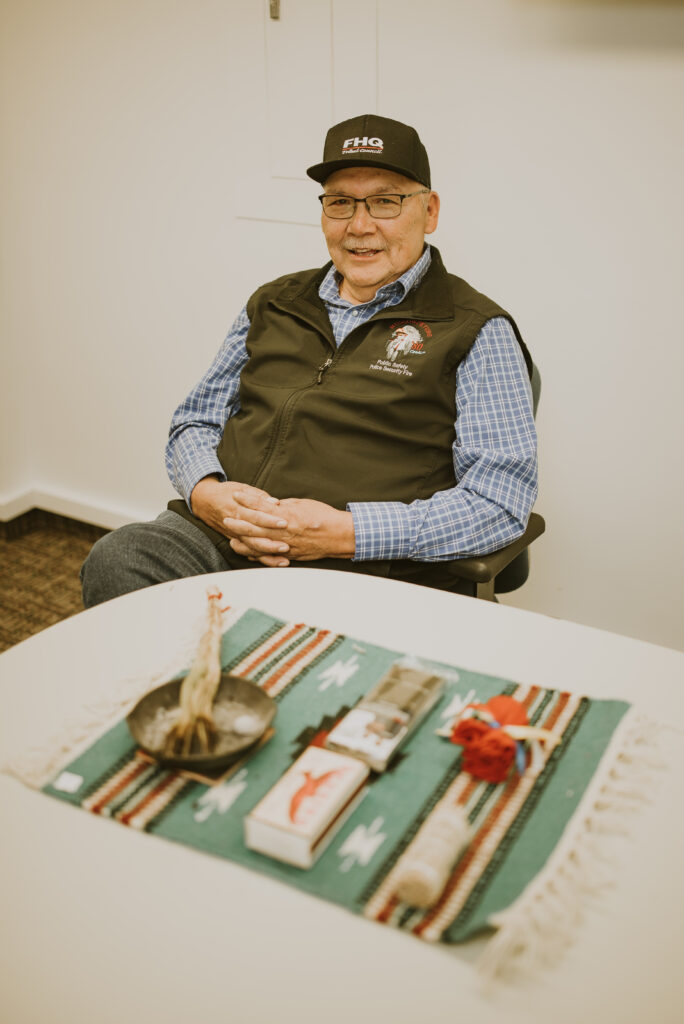Smudging Ceremony a Valuable Learning Opportunity and a Step Toward Truth and Reconciliation
By Charlene Patton | October 2, 2023

A Leadership retreat for staff of Buckingham Inc. included a very special smudging ceremony at the Regina office located on Treaty 4 Territory. The smudge was led by Jim Pratt, Elder helper, from the Muscowpetung First Nation located in Qu‘Appelle Valley, Saskatchewan. Pratt, who was bestowed the honour of carrying forward his ancestral teachings by his late father, calls himself a life-long learner. He constantly strives to retain and share the teachings of the Elders in his community.
Buckingham staff were the recipients of some of those teachings prior to the smudge as Pratt took the time to explain the importance of each element and step involved. “I want people to feel comfortable and be curious about it,” he explained. Pratt’s approachability and sense of ease made it that much easier to feel as such.
The attendees sat in a circle as Pratt offered each the smoke from a braid of sweetgrass to smudge themselves with. Sweetgrass, as Pratt explained, is difficult to find in the meadows and because of this it teaches patience. And patience is something that Pratt asks of everyone on the path of Truth and Reconciliation. “This is a start,” he said. “But don’t rush into it. Keep taking the steps.”
Lance Dudar, co-chair of the Truth and Reconciliation Committee for Buckingham agreed that the smudging ceremony was one small step of many to come. “Holding a smudging ceremony at the Buckingham office demonstrates the company’s commitment to Truth and Reconciliation,” said Dudar. “It shows a willingness to learn and participate in First Nations culture while providing those learning opportunities to all staff.”
Smudging Q & A
Q. What is Smudging?
A. In general terms, smudging is a practice common to Indigenous Peoples in North America wherein smoke is created from burning sacred medicinal plants. This smoke is used to heal the mind, body and soul and to purify or cleanse the energy of a person or place. It also serves as a means for prayers to reach the Creator. Four earth elements are represented in a smudge: the container, traditionally a shell, represents water. The sacred plants represent earth. Lighting the sacred plants represents fire. And the smoke produced represents air. It is important to note that many, but not all, Indigenous cultures in Canada smudge, and many hold different beliefs associated with the smoke. Ceremonies and protocols also vary in different Indigenous cultures.
Q. What type of plant medicine is used in smudging?
A. Four commonly used sacred plants used in smudging are cedar, sage, sweetgrass and tobacco – all are seen as gifts from Mother Earth and are treated with great respect.
Q. What happens during a smudge ceremony?
A. During a smudge, plant leaves or stems are placed in a container and ignited with a match. The flames are then gently extinguished, and the smoke is wafted over the person, either by hand or with an eagle feather. The person being smudged pulls the smoke to them and gently inhales the smoke. The smoke is pulled in toward the eyes, ears and mouth so that the person may see, hear and speak of the goodness that the Creator has given them. Some may smudge their hair, which, in Indigenous culture, is considered their identity and the identity of their ancestors through the DNA. One’s feet may also be smudged as a way to show respect to the earth they walk upon.
Source: ictinc.ca (Indigenous Corporate Training Inc)
Smudging video source: Sask Culture

